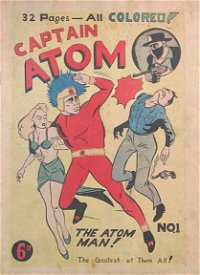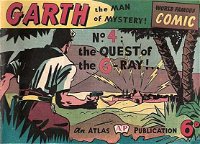Atlas by James Zee
Introducing Atlas Publications
Capitalising on the success of KG Murray's Superman reprints, Atlas Publications entered the comics field in January 194811This date is from p. 190 of John Ryan's Panel by Panel. All of Atlas Publications' output was undated, with... with Captain Atom, a full colour comic by Australians Arthur Mather22Arthur Richard Mather (b.1925) left school aged 15 to become a printing apprentice at The Truth. He also provided political... and Jack Bellew33Jack Bellew (?- 2009?) had a respected and influential newspaper career at the Daily Telegraph (owned by Frank Packer’s Consolidated... (as John Welles).44Early issues also included Australian backups—Jim Atlas and Dr. Peril of Iggo by Stanley Pitt (known for his later science... Wartime bans on imported periodicals were still in place at the time, creating strong demand for new local periodicals.
While early Atlas comics mimicked the look of Murray's contemporary comics, the company quickly created a strong identity by being one of the few Australian comics' publishers to consistently brand its publications on the cover. Until 1951, most of its comics were also printed in a distinctive landscape format that was better suited to its dominant newspaper reprints.
According to Australian comic historian John Ryan,55Page 190, John Ryan, Panel by Panel (1979: Cassell).... Atlas was founded by Bellew and newspaper colleagues, George Warnecke66Glen William (George) Warnecke (1894-1981) was an associate of Frank Packer and is credited with some of the... and Clive Turnbull.77Stanley Clive Perry Turnbull (1906-1975) was born in Tasmania and joined The Mercury newspaper in 1922 before moving to the... However, their participation in Atlas is largely undocumented, suggesting some embarassment at their role in establishing the Australian comic industry and supporting claims that this publishing initiative was primarily itended as a platform for more reputable publications.88See Kevin Patrick's Arthur Mather: Man of the Atom....
Like KG Murray, Atlas soon abandoned costly colour—Captain Atom became black and white with issue 17.99Atlas stopped using colour around mid-1949. KG Murray was also reducing its colour output at that stage with. Captain... However, its bold introduction and dynamic artwork ensured it remained one of the company's most profitable properties. The first issue of Captain Atom sold 100,000 copies and, during the 1950s, Captain Atom Fan Club advertisements reported over 75,000 members.1010Page 190, John Ryan, Panel by Panel (1979: Cassell). Varous reports have Captain Atom selling a million copies during...
Building on the success of its original Captain Atom series, by 1949 Atlas was expanding quickly into black and white reprints of popular newspaper strips such as Tommy of the Big Top, Sergeant Pat of the Radio-Patrol, Terry and the Pirates, Rip Kirby and Garth—alongside more obscure properties such as The Sea Hound.
While most of its output was reprints, Atlas is most remembered for its Australian comics. Two early original series were Keith Chatto's The Lone Wolf, later also drawn by Yaroslav (Larry) Horak, and Terry Trowell's Grey Domino.
Using its reguar artists Horak and Mather, Atlas also produced original Australian material for some of its newspaper strip series, such as Brenda Starr (Larry Horak), Sergeant Pat (Larry Horak, Andrea Bresciani and Arthur Mather) and Secret Agent X9 (as Flynn of the FBI, by Arthur Mather).1111See Kevin Patrick's "Flynn of the FBI: Case Closed!" at Comics Down Under.... It isn't known whether Atlas lost the rights to these properties or simply sought to increase sales through the production of new work.
An advertisement for the Captain Atom Club in late 1951 reports that Atlas produced at least 18 "world famous" ongoing comics at that time: Captain Atom, Lone Wolf, Flynn of the F.B.I., Streamer Kelly, Katzenjammer Kids, King of the Mounties, Buck Ryan, Grey Domino, Garth, Phil Corrigan, Secret Agent X9, Brenda, Sergeant Pat, Danny Hale, Prize Western, Jimpy, Belinda, Johnny Hazard and Jane.1212The competition, closing on 10 January 1952, asked readers to rank Atlas's comics in order of popularity. The winners were...



